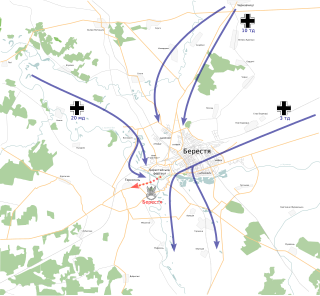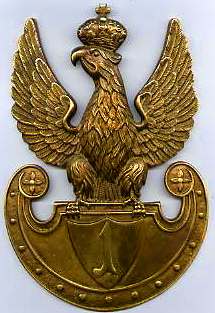
Operation Tempest was a series of uprisings conducted during World War II against occupying German forces by the Polish Home Army, the dominant force in the Polish resistance.

The Battle of the Bzura was the largest Polish counter-attack of the German invasion of Poland and was fought from 9 to 19 September. The battle took place west of Warsaw, near the Bzura River. It began as a Polish counter-offensive, which gained initial success, but the Germans outflanked the Polish forces with a concentrated counter-attack. That weakened Polish forces and the Poznań and Pomorze Armies were destroyed. Western Poland was now under German occupation. The battle has been described as "the bloodiest and most bitter battle of the entire Polish campaign". Winston Churchill called the battle an "ever-glorious struggle".

The Battle of Brześć Litewski was a World War II battle involving German and Polish forces that took place between 14 and 17 September 1939, near the town of Brześć Litewski. After three days of heavy fights for the stronghold in the town of Brześć, the Germans captured the fortress and the Poles withdrew.

The 28 Dywizja Piechoty was a Polish Army infantry division which saw action against the invading Germans during the Invasion of Poland of World War II. The division suffered heavy casualties in battles near Łódź and the remnants retreated to Warsaw, where they surrendered.

The Volhynian Cavalry Brigade was a Polish cavalry brigade, which saw action against the invading Germans during the Invasion of Poland, a part of World War II. Raised from recruits in the area of Wołyń, the division was posted to the Łódź Army. During several desperate counter-attacks, the brigade suffered heavy casualties near Łódź. It was commanded by Colonel Julian Filipowicz. Most notably, the unit took part in one of the first battles of the German invasion of Poland, the battle of Mokra.

Polish 1st Legions Infantry Division is a tactical unit of the Polish Army. Formed on February 20, 1919, partially of veterans of the I Brigade of the Polish Legions, the unit saw extensive action during the Polish-Bolshevik War and World War II. Regarded by the soldiers of the Wehrmacht as the Iron Division, it distinguished itself in the Invasion of Poland.

The Battle of Radom, also known as the Battle of Iłża, was part of the Invasion of Poland during the Second World War. It lasted from 8 September 1939 to 9 September 1939. Polish troops of the Prusy Army, under General Stanisław Skwarczyński, defended the city of Iłża and the road from Sandomierz to Radom. The Poles were not ready to meet head on overwhelming German XV Army Corps, and were easily defeated after two days of fighting. Prusy Army, in the aftermath of the battle, ceased to exist. Some of the army's units joined other tactical groupings of the Polish armed forces.

The 7th Infantry Division was the name of several units of the Polish Army.
Polish 2nd Legions Infantry Division was a tactical unit of the Polish Army between the World Wars. Formed on February 21, 1919, in the towns of Zegrze and Jablonna near Warsaw, and composed mostly of veterans of the Polish Legions in World War I, the unit saw extensive action during the Polish-Bolshevik War and the Invasion of Poland.
The Polish 4th Infantry Division was created following Polish independence after the end of World War I. The division participated in the Polish–Ukrainian War in 1919. During World War II, the division existed as three wholly separate organizations, the original incarnation of the division as part of the pre-war Polish Army, the second incarnation armed and equipped by the western Allies, and another division armed and equipped and controlled by the Soviet Union. The second and third incarnations of this division existed simultaneously from 1944 until 1947.
Polish 3rd Legions Infantry Division was a tactical unit of the Polish Army between the World Wars. Formed in 1919, as a third unit composed significantly of veterans of the Polish Legions in World War I, it saw extensive action during the Polish-Bolshevik War and the Invasion of Poland. In the interbellum period, the headquarters of the division was stationed in Zamość, while its regiments were garrisoned in Chelm, Lublin, Zamosc and other locations.

The 9th Infantry Division was a unit of the Polish Army in the Second Polish Republic. For most of 1919, the 9th Division's regiments were dispersed across the regions of Podlachia, Polesie and Volhynia, with one battalion sent to Dąbrowa Basin.

15th "Greater Poland" Infantry Division was a unit of the Polish Army in the interbellum period. Founded on February 17, 1920, and based on the 2nd Greater Poland Rifles Division, it actively participated in the Polish-Soviet War, including the Kiev offensive (1920), and the Battle of Warsaw. After Polish victory, the Division pushed the Red Army out of northern Mazovia. It then fought in the Battle of the Niemen River.

14 Greater Poland Infantry Division was a unit of the Polish Army in the interbellum period, which took part in the Polish September Campaign.

The Masovian Cavalry Brigade was a cavalry unit of the Polish Army in the interbellum period, which took part in the Polish September Campaign. It was created on April 1, 1937, out of former 1st Cavalry Brigade. Its headquarters were in Warsaw, with other units stationed in towns around the capital:

29th Grodno Infantry Division was a unit of the Polish Army during the interbellum period. It was created in early 1920s, after the army of Republic of Central Lithuania was absorbed by the Polish Army. The newly created unit took over regiments that had been part of 1st Lithuanian-Belarusian Infantry Division.
5th Lwów Infantry Division was a unit of the Polish Army in the interbellum period, with headquarters stationed in Lwów. It was created on May 20, 1919, during the Polish–Ukrainian War in Eastern Galicia. Originally, it consisted of three infantry regiments, but later it was strengthened with additional two. During Polish September Campaign it was commanded by General Juliusz Zulauf. The Division consisted in September 1939 of these regiments:

Polish 24th Infantry Division was a unit of the Polish Army in the interbellum period, which took part in the Polish September Campaign. The Division was created in 1921, and its first commandants were: General Jan Hempel, General Wacław Scaevola-Wieczorkiewicz, Colonel Boleslaw Maria Krzyzanowski, and Colonel Boleslaw Schwarzenberg-Czerny. The 24th Division's headquarters were located in Jarosław, with some regiments stationed in nearby cities of Rzeszów and Przemyśl. It consisted of:

The 41st (Reserve) Infantry Division was a tactical unit of the Polish Army during the early stages of World War II.

First Legions Infantry Regiment of Józef Piłsudski was an infantry regiment of the Polish Army in 1914-1939. Named after Józef Piłsudski, in the Second Polish Republic it was stationed in the city of Wilno.
















